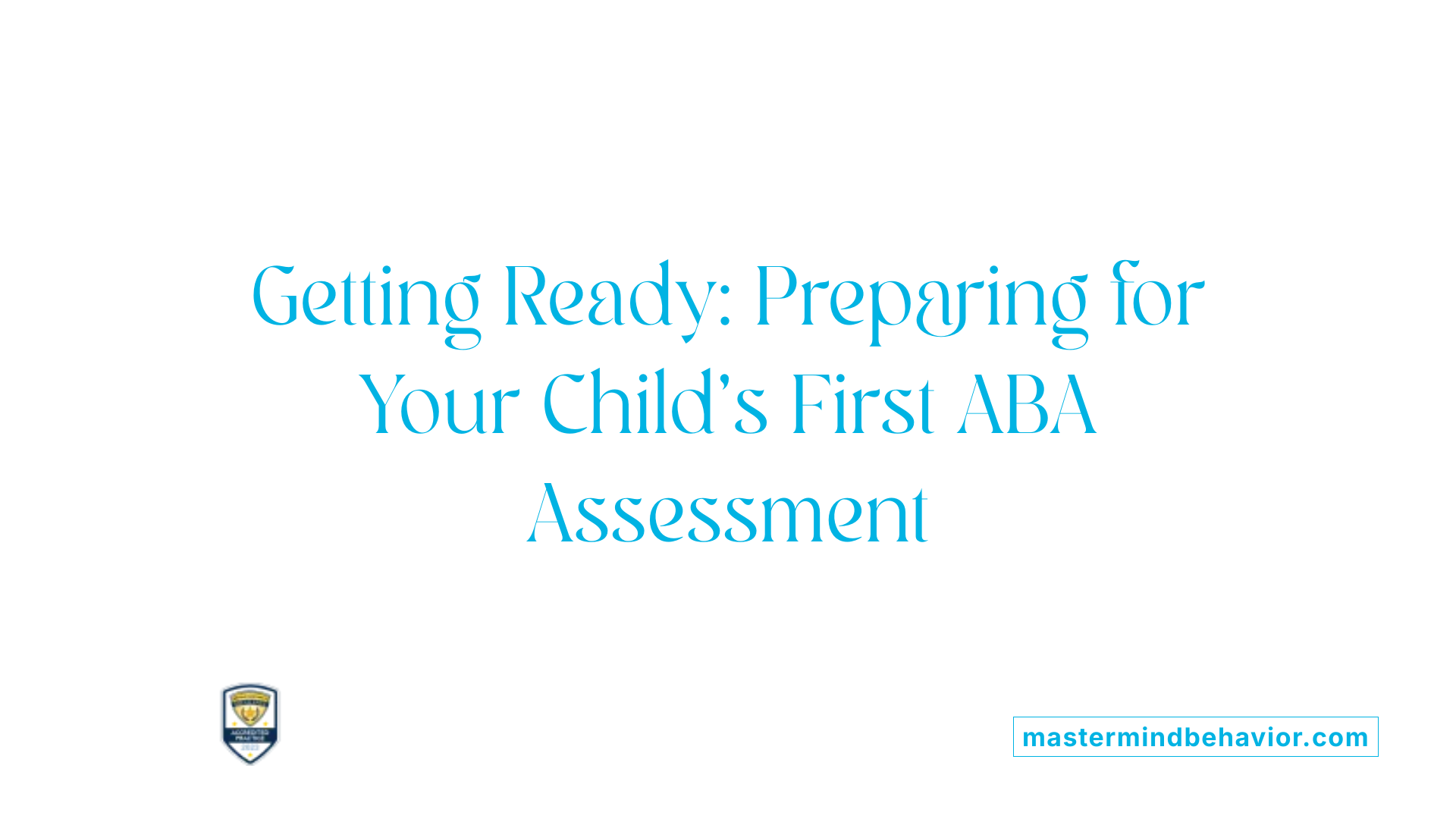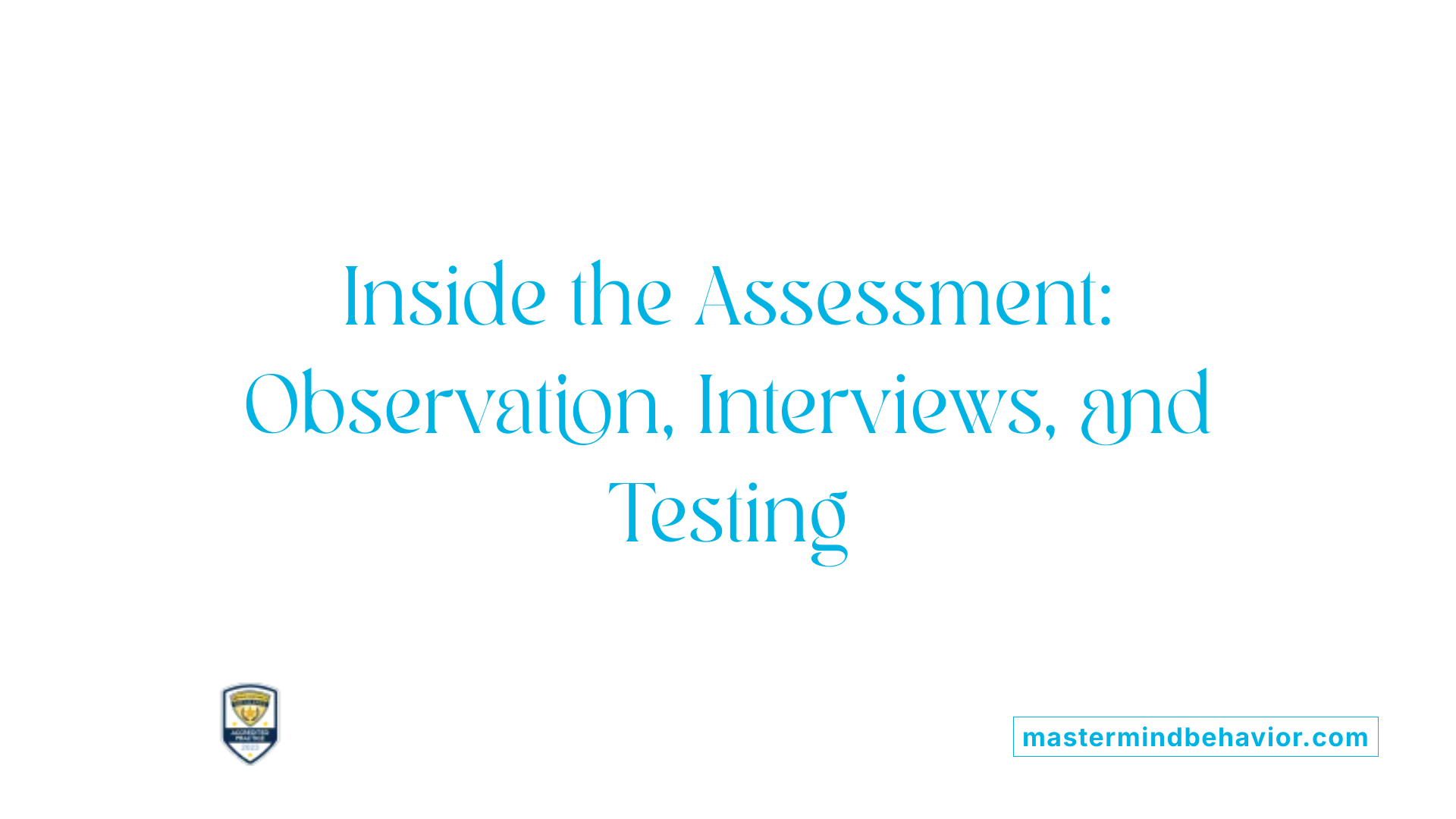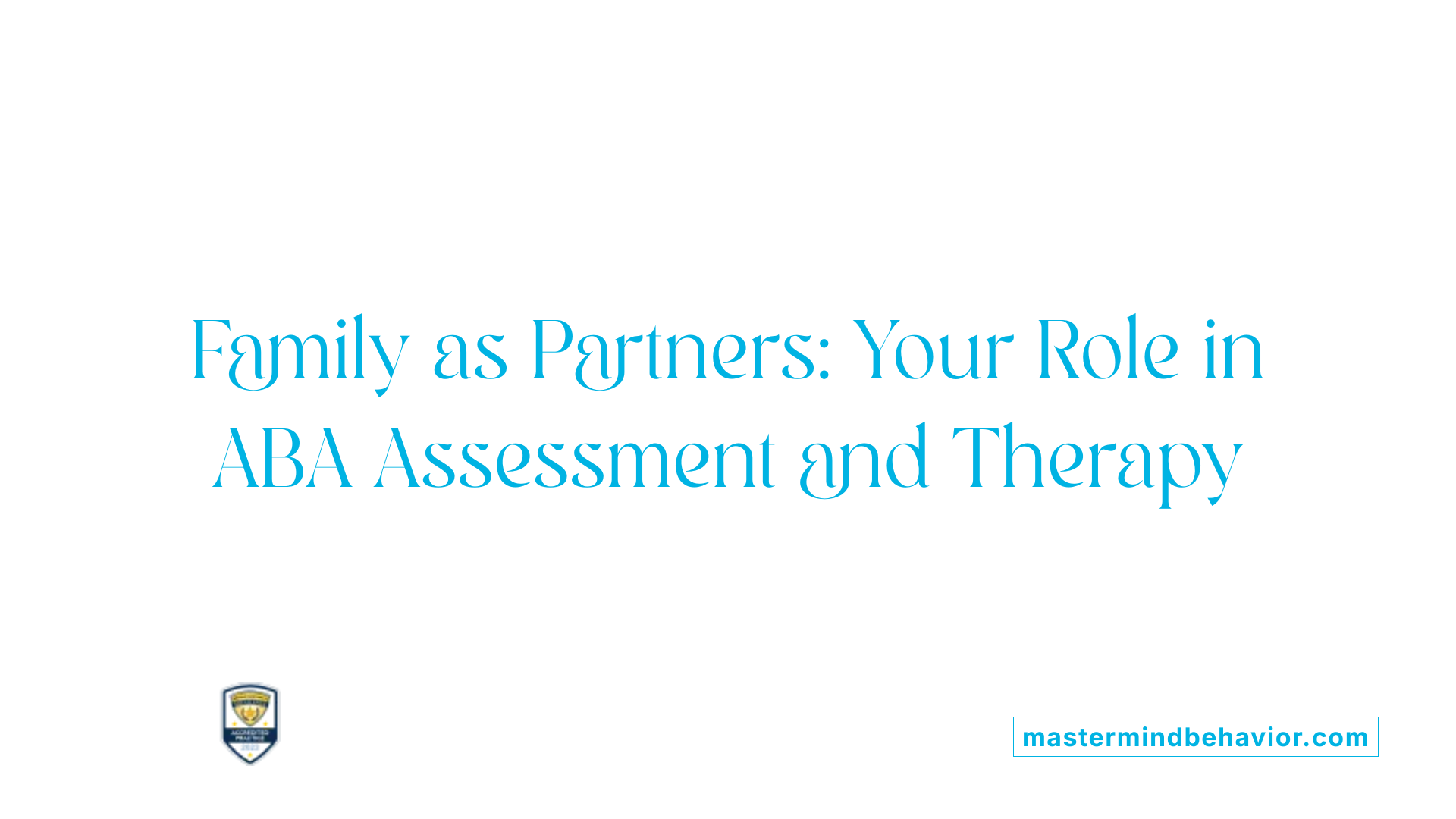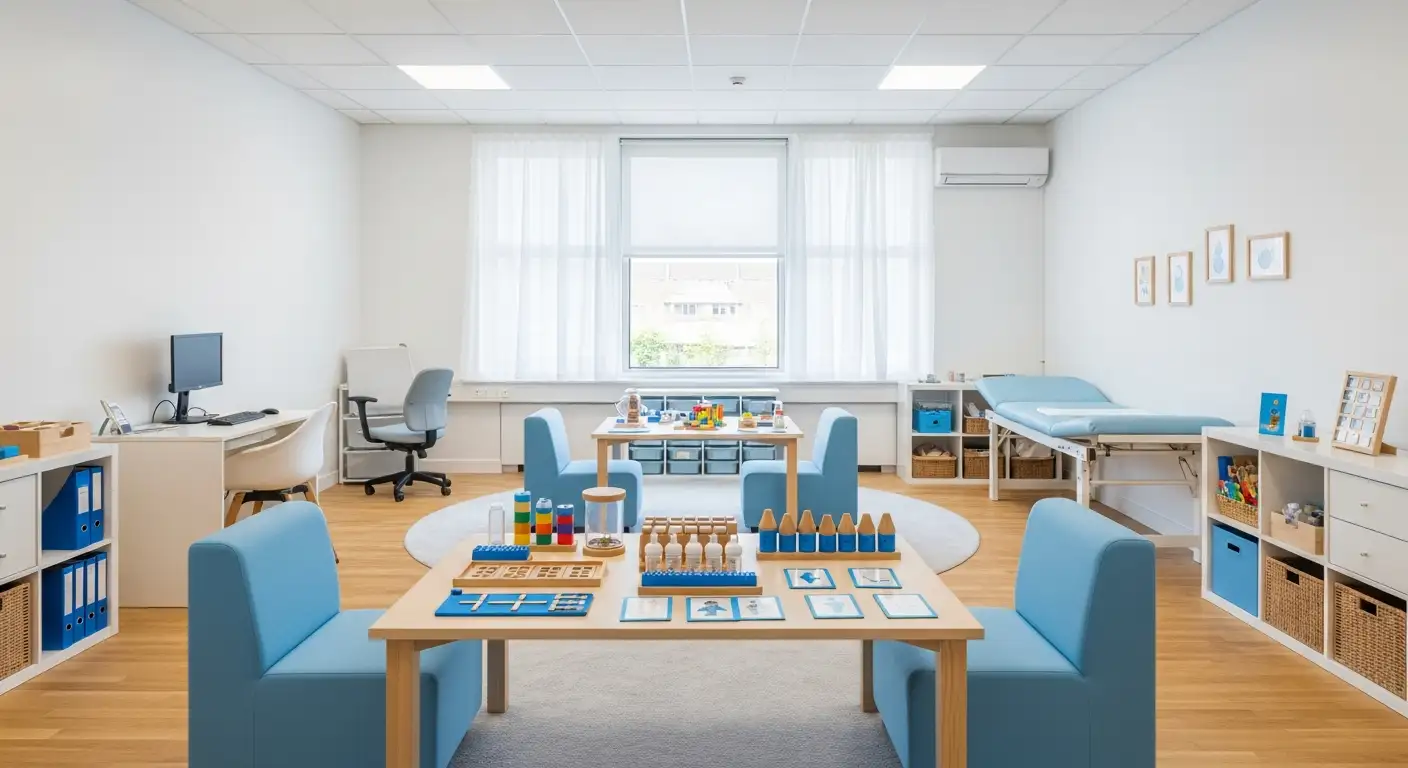What to Expect During Your Child’s Initial ABA Assessment

Introduction to Initial ABA Assessments
Beginning ABA therapy starts with a comprehensive assessment tailored to understand your child's unique strengths, challenges, and needs. This initial evaluation lays the groundwork for a personalized therapy plan aimed at helping your child flourish. Here's what families can expect during this important first step in the ABA journey.
What is Applied Behavior Analysis (ABA) Therapy?
What is Applied Behavior Analysis (ABA) therapy?
Applied Behavior Analysis (ABA) therapy is a science-based treatment that focuses on improving specific behaviors and skills, especially for individuals with autism spectrum disorder (ASD). It is grounded in principles of learning and behavior, emphasizing how environment influences actions. ABA uses methods like positive reinforcement to encourage helpful behaviors and reduce those that may hinder learning or social interaction.
How is ABA therapy individualized?
Each ABA program is carefully tailored to the individual’s unique needs. A Board Certified Behavior Analyst (BCBA) conducts detailed assessments to understand skills, challenges, and interests. This ensures therapy targets the child’s strengths and areas for growth. Families’ input is also integral, allowing goals to be meaningful and practicable.
What are the key principles of ABA therapy?
Positive reinforcement is central to ABA, rewarding desired behaviors to increase their frequency. Alongside this, careful data collection during sessions tracks progress and guides necessary adjustments. Therapists utilize structured techniques, such as Discreet Trial Training, and naturalistic methods like Pivotal Response Treatment, offering flexible approaches to teaching.
Who designs and oversees ABA programs?
A BCBA designs the treatment plan and supervises therapy implementation. These professionals are extensively trained and ensure interventions follow scientific standards, adapting goals as the child develops.
What goals does ABA therapy target?
ABA aims to improve communication, social skills, self-care, play, motor skills, and academic abilities. Through consistent and personalized intervention, children often gain greater independence and improved quality of life.
| Topic | Description | Additional Details |
|---|---|---|
| Definition and Basis | Science of learning and behavior to improve specific skills | Focuses on environmental impact on behavior |
| Individualized Approach | Customized programs designed by BCBAs based on thorough assessment | Family preferences and strengths considered |
| Key Principles | Positive reinforcement, data collection, various teaching methods | Includes Discreet Trial Training and Pivotal Response Treatment |
| Role of BCBAs | Assessment, program design, supervision, and ongoing progress monitoring | Ensures adherence to evidence-based practices |
| Therapy Goals | Enhance communication, social skills, self-care, play, and motor and academic skills | Targets functional independence and meaningful development |
The Purpose and Components of the Initial ABA Assessment

Holistic understanding of child’s needs, strengths, and challenges
The initial ABA assessment is designed to develop a comprehensive picture of a child’s unique abilities and difficulties. It gathers information on the child’s strengths and limitations to guide a personalized treatment plan that addresses their specific needs.
Observation and testing of communication, social, motor, and daily living skills
During the assessment, professionals observe the child's play and interactions, evaluating skills such as independence in play, joint attention, ability to follow directions, sharing, and turn-taking. Standardized testing and direct observations assess communication, social, motor, and daily living skills to understand the child’s functional capabilities.
Functional Behavior Assessment (FBA) and other assessment tools
Various assessment methods are employed, including the Functional Behavior Assessment (FBA), which examines behaviors to inform intervention strategies. Other tools like the Verbal Behavior Milestones Assessment and Vineland Adaptive Behavior Scales help evaluate developmental milestones and adaptive behaviors.
Caregiver interviews and family involvement
Family participation is critical throughout the assessment. Interviews with caregivers provide essential insights into the child's behavior and history, ensuring that treatment plans align with family observations and goals. This partnership helps tailor interventions effectively.
Review of intake packets, consent forms, and background documents
The process starts with filling out intake paperwork, including consent forms and background information. Professionals review diagnostic reports and assessment notes to complete a thorough evaluation, usually within a week. These documents support a thorough understanding required to formulate individualized treatment plans.
Who Conducts the ABA Assessment and What is Their Role?
Role of Board Certified Behavior Analysts (BCBAs) and Center Supervisors
ABA assessments are primarily conducted by Board Certified Behavior Analysts (BCBAs) or Center Supervisors. These professionals hold specialized credentials and have extensive training in behavioral analysis. They lead the assessment process by observing the child, conducting caregiver interviews, and reviewing documents such as diagnostic reports and developmental history.
Involvement of Trained Therapists and Clinicians
Alongside BCBAs, trained therapists—including Registered Behavior Technicians (RBTs) and behavior interventionists—play a crucial role in implementing ABA therapy. While they deliver the day-to-day treatment, they work under the close supervision of BCBAs to ensure therapy fidelity and effectiveness.
Gathering Background Information through Interviews and Observation
The assessment process involves comprehensive data collection through parent and caregiver interviews to understand the child's unique strengths and challenges. Direct observation in natural settings enables professionals to evaluate behaviors like play skills, communication, and social interaction, providing critical insights for treatment planning.
Interpreting Assessment Results to Design Individualized Plans
After completing observations and collecting data, BCBAs analyze the results to identify target behaviors and skill deficits. This interpretation informs the development of a tailored treatment plan that aligns with the child’s needs, family preferences, and therapeutic goals.
Coordination with Multidisciplinary Teams if Applicable
In many cases, ABA providers collaborate with a multidisciplinary team, including psychologists, speech therapists, and occupational therapists, to create a holistic intervention approach. This coordination ensures that the child's diverse needs are met comprehensively.
Who Typically Provides ABA Therapy Services?
ABA therapy is typically provided by licensed professionals known as Board Certified Behavior Analysts (BCBAs), who design and oversee treatment plans. Trained therapists, often behavior technicians or assistants, implement the therapy under supervision. Specialized autism centers may engage multidisciplinary teams including psychologists and speech therapists. Behavior interventionists and paraprofessionals also deliver services when properly trained and supervised. Overall, ABA therapy involves qualified, dedicated professionals committed to supporting children with autism spectrum disorder (ASD).
Preparing for Your Child’s Initial ABA Assessment

What Documents Should You Bring?
Bringing comprehensive documentation helps create a clear picture of your child's needs. Essential documents include developmental history summaries, medical records, previous diagnostic reports, and any relevant observations or notes from caregivers and professionals like teachers.
What Is the Role of Intake Packets and Consent Forms?
Intake packets typically contain introduction letters, contact information, and consent forms necessary for starting the assessment process. Filling these out beforehand streamlines administrative tasks and ensures clear communication.
How Can You Prepare Your Child?
Preparing your child involves explaining what to expect in simple terms and creating a comfortable environment. Familiar items or toys can help ease anxiety during observations.
Why Gather Observations and Notes from Family and Professionals?
Caregiver and professional insights offer valuable perspectives on your child’s behaviors and skills across different settings. This input guides tailored intervention strategies.
What Happens During the Assessment in Natural Settings?
The assessment often includes direct observations of your child in familiar environments, like home or school. Skills such as independence in play, joint attention, and social interactions are evaluated to better understand your child’s strengths and challenges.
The Assessment Process: Observation, Interviews, and Testing

Direct Observation of Child’s Play, Interaction, Communication, and Behaviors
The assessment begins with a Board-Certified Behavior Analyst (BCBA) or center supervisor observing the child in natural settings. This observation focuses on how the child plays independently, engages in joint attention, follows directions, shares, and takes turns. Evaluating these behaviors provides insight into the child's current abilities and social skills.
Parent and Caregiver Interviews to Collect Family Insights and Goals
Caregiver input plays a crucial role in the assessment process. Through interviews, parents share observations about their child’s strengths, challenges, and behavior patterns. These insights help shape individualized treatment goals and ensure the therapy plan aligns with family expectations.
Standardized Assessment Tools Like Vineland Adaptive Behavior Scales
Standardized tools such as the Vineland Adaptive Behavior Scales assess communication, socialization, daily living skills, and motor development. These evaluations quantify the child’s skills and identify areas needing support, providing a structured overview alongside observational data.
Evaluations of Social Skills, Motor Abilities, and Daily Living Tasks
The assessment also includes a thorough evaluation of social communication, motor skills, and daily living activities. This multipronged approach ensures a comprehensive understanding of the child’s functional abilities to tailor therapy effectively.
Use of Functional Behavior Assessment (FBA) to Identify Behavior Triggers
An important part of the assessment is the Functional Behavior Assessment (FBA), which identifies specific environmental factors that trigger challenging behaviors. Understanding these triggers allows the development of intervention strategies to reduce problematic behaviors while promoting positive ones.
All gathered information—from observations, interviews, standardized testing, and FBAs—contributes to crafting an individualized ABA treatment plan that targets the child's unique needs and strengths.
Understanding the Role of Family in the ABA Assessment and Therapy

Family’s Active Participation in Interviews and Data Collection
Family involvement is a cornerstone in the ABA assessment process. Parents and caregivers actively participate by sharing rich information during interviews and helping collect behavior data. This hands-on engagement provides a fuller picture of the child's natural behaviors and challenges.
Providing Comprehensive Background and Insights About Child's Behavior
Caregivers offer detailed background stories and daily observations that shed light on the child's unique traits, strengths, and needs. This insight is critical for understanding behaviors in real-life contexts that may not be evident during clinical observation alone.
Importance of Caregiver Input in Shaping Treatment Goals
The information gathered from families helps shape realistic and meaningful treatment goals. Caregiver input ensures that therapy targets not only clinical improvements but also skills that matter most to the family’s daily life and the child’s future independence.
Collaborative Approach to Therapy Planning
ABA therapy planning is a collaborative process. Families work alongside BCBAs and therapists to design personalized intervention plans that consider preferences, routines, and values. This partnership promotes therapies that fit well into the child’s and family’s lifestyle.
How Ongoing Family Involvement Supports the Child’s Progress
The work doesn’t stop after assessment. Families stay deeply involved by providing continuous feedback about progress and challenges. This ongoing partnership allows the therapy team to adapt goals and methods to best support the child’s development over time.
Overall, family participation transforms the ABA assessment and intervention from a clinical exercise into a dynamic, responsive process centered around the child’s real-world needs and successes.
How ABA Therapy Supports Children with Autism: From Assessment to Intervention
Connection Between Initial Assessment and Personalized Intervention Plans
ABA therapy begins with a comprehensive assessment process designed to understand the unique strengths, challenges, and needs of a child with autism. This evaluation includes observations, caregiver interviews, and skill testing, which allow a Board-Certified Behavior Analyst (BCBA) to create a carefully tailored treatment plan. The individualized plan focuses on the child’s specific behaviors and developmental goals, ensuring therapy targets meaningful and measurable outcomes.
Use of Assessment Results to Set Measurable Behavioral Goals
Results from assessments such as the Functional Behavior Assessment (FBA) and the Vineland Adaptive Behavior Scales help identify the environmental factors and skill deficits that affect the child’s behavior. With these insights, measurable goals are formulated, often centered around improving communication, social interaction, daily living skills, and motor abilities. This approach ensures objectives are clear, trackable, and relevant to the child’s day-to-day life.
Examples of Targeted Goals Such as Communication, Social Interaction, and Self-Care
Common goals in ABA therapy include enhancing language and communication skills like following directions or initiating conversations, improving social interactions such as sharing and turn-taking, and fostering self-care activities including eating independently and dressing. Play skills and motor coordination are also frequent focuses to support holistic development.
Techniques Used in ABA to Reinforce Positive Behaviors and Reduce Challenges
Positive reinforcement is a core strategy in ABA, where rewarding desirable behaviors increases their occurrence. Therapists utilize methods like prompting, modeling, behavior chaining, and systematic teaching within naturalistic settings to encourage learning. Challenging behaviors are addressed through identifying triggers and teaching alternative, functional skills, rather than punishment.
How Therapy Is Adjusted Based on Ongoing Data and Progress
Progress is continuously monitored through detailed data collection during therapy sessions. This ongoing measurement allows therapists and families to see how the child responds to interventions and make necessary adjustments. This dynamic process ensures that the therapy remains effective and responsive to the child’s evolving abilities and needs.
How does ABA therapy work to support individuals with autism?
ABA therapy works by scientifically analyzing and modifying behavior through techniques that reinforce positive actions and reduce problematic ones. It begins with a thorough assessment, such as a Functional Behavior Assessment (FBA), to identify environmental factors influencing behavior. Using methods like positive reinforcement, prompting, modeling, and behavior chaining, therapists teach new skills and encourage desirable behaviors in natural settings. Data collection and progress monitoring are integral to tailoring interventions and ensuring meaningful improvements over time. Overall, ABA is an evidence-based approach that helps individuals with autism develop skills in communication, social interaction, and independence while decreasing challenging behaviors.
Common Behavioral Goals Targeted in ABA Therapy
What are some common behavioral goals targeted in ABA therapy for autism?
ABA therapy for autism focuses on increasing socially important behaviors such as social interactions, communication, and expressive language. These goals help children better connect with others and express their needs effectively.
At the same time, ABA works to reduce challenging behaviors like aggression, self-injury, and other disruptive patterns that interfere with learning and daily functioning. Reducing these behaviors supports a safer and more supportive environment for the child.
Functional skills and independence are also central targets. These include teaching self-care routines, motor skills, play skills, and academic abilities, all tailored to the child's individual strengths and needs.
ABA employs evidence-based methods such as Discrete Trial Training (DTT), Pivotal Response Treatment (PRT), and naturalistic teaching strategies. These approaches use positive reinforcement and promote skill generalization across settings like home and school.
Goals in ABA are clearly defined and measurable, allowing careful monitoring of progress through ongoing data collection. This ensures that therapy is adapted as the child develops, maximizing effectiveness and personal relevance.
Overall, ABA therapy aims to enhance independence and quality of life by teaching meaningful skills while minimizing behaviors that limit learning and social engagement.
Evaluating the Effectiveness of ABA Therapy

How effective is ABA therapy for individuals with autism?
Applied Behavior Analysis (ABA) therapy stands out as a highly effective, evidence-backed treatment for individuals with autism spectrum disorder (ASD). Scientific research supports its ability to significantly improve social interaction, communication skills, and daily living abilities.
Scientific validation and evidence supporting ABA for ASD
ABA has been studied since the 1960s and is endorsed by major organizations such as the US Surgeon General and the American Psychological Association. It employs techniques like positive reinforcement—rewarding desirable behaviors to encourage their recurrence—alongside task analysis and naturalistic teaching methods. These strategies help children develop language, focus, memory, social skills, and reduce harmful or learning-impairing behaviors.
Improvements observed in social, communication, and daily living skills
Children receiving ABA therapy often demonstrate measurable progress in areas including self-care, play, joint attention, following directions, and turn-taking. The therapy’s individualized approach, tailored by Board-Certified Behavior Analysts (BCBAs), ensures interventions focus on each child’s strengths and challenges, maximizing outcomes. Data collection throughout therapy allows for ongoing adjustment to meet evolving goals.
Importance of early and intensive intervention
Research highlights that early and intensive ABA interventions yield the most meaningful and sustained improvements. Beginning treatment during early childhood enhances language acquisition and behavioral development, promoting greater independence and quality of life over time.
Consideration of ethical and respectful therapy approaches
Modern ABA emphasizes respectful, child-centered methods, steering clear of aversive or punitive strategies once criticized in the therapy’s history. Current programs prioritize collaboration with families and honoring each child's individuality and preferences.
Ongoing monitoring and flexibility in treatment plans
An integral part of ABA’s effectiveness is continuous progress assessment. Therapists and BCBAs regularly review and modify programs to reflect the child’s development and changing needs. This flexibility ensures therapy remains relevant and effective throughout different stages of growth.
ABA therapy’s strong scientific foundation, focus on meaningful skill development, and adaptable, respectful delivery contribute to its standing as a leading intervention for children and adults on the autism spectrum.
Next Steps After the Initial ABA Assessment
Review of assessment results and development of individualized treatment plan
Once the initial ABA assessment is complete, the Board-Certified Behavior Analyst (BCBA) reviews all gathered information, including observation notes, parent interviews, and standardized tests. This comprehensive review helps create a personalized treatment plan tailored specifically to the child's strengths, needs, and behavior goals. The plan outlines targeted interventions aiming to improve communication, social skills, play, and daily living tasks.
Insurance authorization and financial responsibilities
Before therapy begins, the treatment plan and assessment report are submitted to the insurance provider for authorization. Insurance coverage often depends on approval of these documents to confirm the medical necessity of ABA services. Families are informed about copays, deductibles, and any other financial responsibilities early in the process to ensure transparency.
Scheduling the start of therapy services
After insurance approval, the center coordinates with families to schedule therapy sessions in settings like home, school, or community based on what best fits the child’s needs. This step is important to establish a routine that supports consistent skill development.
Importance of ongoing progress monitoring and updates
ABA therapy includes continuous data collection and progress evaluations, enabling therapists to adjust goals and strategies as the child develops. Regular updates keep families informed and involved in the child’s progress, ensuring that interventions remain effective and relevant.
Long-term support and family-provider collaboration
Long-term support is essential for sustained gains. Families are encouraged to maintain close communication with providers to share observations and participate in ongoing assessments. This collaboration strengthens the therapy’s impact and allows for timely adaptations aligned with the child’s evolving needs.
Conclusion: Embracing the ABA Assessment Journey
The initial ABA assessment is a crucial and comprehensive step in tailoring effective therapy that supports your child's growth and learning. With the expertise of certified professionals, active family involvement, and evidence-based approaches, families gain clarity and direction for impactful interventions. Understanding what to expect during this process empowers caregivers to advocate for their children and participate fully in the creation of personalized treatment plans. The journey through ABA therapy, beginning with a thorough assessment, offers hope and proven support for enhancing the lives of children with autism spectrum disorder.
References
- ABA Assessment Guide For Parents
- What to Expect During An Initial ABA Assessment
- Autism ABA Therapy Evaluations: What to Expect and How ...
- Applied Behavior Analysis (ABA)
- Board Certified Behavior Analyst
- How to Become an ABA Therapist - School of Education
- How to Become an Applied Behavior Analyst (ABA) Therapist
Recent articles

Teaching Independent Decision Making Through ABA
Unlocking Autonomy: The Role of ABA in Fostering Independent Decision Making

The Role Of ABA Therapy In Supporting Children With Social Challenges
Unlocking Social Potential: How ABA Therapy Empowers Children with Autism

The Role Of ABA Therapy In Developing Self Determination Skills
Unlocking Independence: How ABA Therapy Empowers Self-Determination in Autism

ABA Therapy For Supporting Flexibility In New Social Groups
Enhancing Social Adaptability in Autism Through Applied Behavior Analysis

ABA Therapy For Increasing Peer Engagement During Play
Enhancing Social Interaction Through ABA Techniques in Autism Therapy

ABA Therapy For Increasing Peer Engagement During Play
Enhancing Social Interaction in Autism Through Play-Based ABA Therapy



